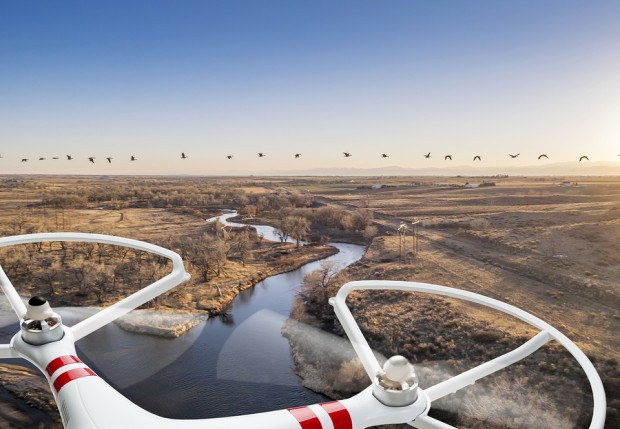The FAA’s new partnership with industry to explore the use of commercial drones in newsgathering, agricultural and railroad industries is drawing a cautiously optimistic reaction from the P/C insurance industry. They welcome the move, but some are worried about how it will impact the claims process.
Others want insurers to win similar test program partnerships for themselves.
“The FAA’s announcement … is a positive step forward in advancing the use of [commercial drones] for a variety of useful purposes that will benefit the public interest,” Chris Hacket, director, personal lines policy for the Property Casualty Insurers Association of America, told Carrier Management via email.
Hacket said that the initiative – known as the Pathfinder Program – creates many possibilities, but that insurers must also be included.
“PCI is hopeful that the FAA will partner with the insurance industry to expand [drone] usage so that companies can survey property damage after a disaster and help expedite claim adjustment to get settlement checks to policyholders sooner.”
In the short term, the FAA has been granting insurers waivers to allow them to test drones for use in their claims and underwriting processes, including Erie Insurance, AIG, USAA and State Farm.
Regulators with the Federal Aviation Administration are launching three partnerships as part of the Pathfinder Program, which they announced on May 6.
The FAA will link with CNN to see how drones could be used safely for newsgathering in populated areas. Regulators will also work with drone manufacturer PrecisionHawk to see how drones flights could be safely allowed outside of a pilot’s direct line of sight. As well, they’ll team with BNSF Railway – a railroad operator owned by Warren Buffett’s Berkshire Hathaway – to see what obstacles there are in using drones to inspect rail system infrastructure.
Meanwhile, the FAA is continuing to develop regulations for commercial drone use.
Carol Kreiling, senior claim manager with Swiss Re, said that Pathfinder’s success could propel a wide-ranging increase in the use of commercial drones in the U.S., which would “have ramifications for insurance companies.”
“The current dearth of [commercial drone] loss data makes it difficult for insurance companies to properly price insurance policies covering drone use,” Kreiling told Carrier Management via email. “It is therefore no surprise that only a handful of insurers actually issue standalone drone insurance coverage, such as Zurich Insurance in Canada, and Tokio Marine in the Lloyd’s of London market.”
Kreiling added, however, that the program could also bring back to the U.S. research and development in commercial drone use currently taking place in the United Kingdom, Australia and other countries. The work isn’t being done here, she said, due to the FAA’s current requirement that drones must be used within a pilot’s visual line of sight.
Anthony Mormino, Swiss Re’s senior legal counsel, said that the Pathfinder Program shows the FAA “is serious about moving quickly to safely and practically integrating commercial drone use in the U.S.”
Letting drone flights go beyond the sight of a drone operator “is key to unlocking the true potential of commercial drone use,” he said.





















 Breaking: Andersen to Replace Zaffino as CEO of AIG on June 1
Breaking: Andersen to Replace Zaffino as CEO of AIG on June 1  Executives on the Move at Liberty Mutual, Cowbell, W. R. Berkley
Executives on the Move at Liberty Mutual, Cowbell, W. R. Berkley  How Insurers Can Avoid Post-Merger Technology Failure
How Insurers Can Avoid Post-Merger Technology Failure  First Atlantic Hurricane Forecast for 2026 Suggests Season Close to 30-Year Norm
First Atlantic Hurricane Forecast for 2026 Suggests Season Close to 30-Year Norm 





